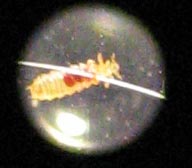Polyplax spinulosa
Polyplax spinulosa is a species of sucking louse that primarily infests rodents, particularly rats. It belongs to the family Polyplacidae. This ectoparasite is known for its role in the transmission of various pathogens and can have significant health impacts on its host.
Description[edit | edit source]
Polyplax spinulosa is a small, wingless insect with a dorsoventrally flattened body, adapted for a parasitic lifestyle. The body is divided into three parts: the head, thorax, and abdomen. The head bears specialized mouthparts for piercing and sucking blood from the host. The thorax is equipped with three pairs of legs, each ending in a claw adapted for clinging to the host's fur. The abdomen is segmented and can expand as the louse feeds.
Life Cycle[edit | edit source]
The life cycle of Polyplax spinulosa includes three stages: egg (nit), nymph, and adult. The female louse lays eggs on the host's fur, which hatch into nymphs. Nymphs undergo several molts before reaching adulthood. The entire life cycle can be completed in a few weeks, depending on environmental conditions and the availability of a host.
Host and Habitat[edit | edit source]
Polyplax spinulosa primarily infests Rattus rattus (the black rat) and Rattus norvegicus (the brown rat). These lice are typically found in the fur of their hosts, particularly around the neck and shoulders. Infestations are more common in environments where rats are abundant, such as urban areas, sewers, and agricultural settings.
Medical and Veterinary Importance[edit | edit source]
Polyplax spinulosa is of medical and veterinary importance due to its role in the transmission of various pathogens. It can transmit Rickettsia typhi, the causative agent of murine typhus, and other bacterial and viral diseases. Heavy infestations can lead to anemia and weaken the host, making them more susceptible to other infections.
Control and Prevention[edit | edit source]
Control of Polyplax spinulosa involves managing the rodent population and maintaining good hygiene in areas where rodents are present. Insecticidal treatments can be used to reduce louse populations on infested animals. Regular monitoring and prompt treatment of infestations are essential to prevent the spread of lice and associated diseases.
Related Pages[edit | edit source]
| Polyplax spinulosa | |
|---|---|
| Kingdom: | Animalia |
| Phylum: | Arthropoda |
| Class: | Insecta |
| Order: | Phthiraptera |
| Family: | Polyplacidae |
Search WikiMD
Ad.Tired of being Overweight? Try W8MD's physician weight loss program.
Semaglutide (Ozempic / Wegovy and Tirzepatide (Mounjaro / Zepbound) available.
Advertise on WikiMD
|
WikiMD's Wellness Encyclopedia |
| Let Food Be Thy Medicine Medicine Thy Food - Hippocrates |
Translate this page: - East Asian
中文,
日本,
한국어,
South Asian
हिन्दी,
தமிழ்,
తెలుగు,
Urdu,
ಕನ್ನಡ,
Southeast Asian
Indonesian,
Vietnamese,
Thai,
မြန်မာဘာသာ,
বাংলা
European
español,
Deutsch,
français,
Greek,
português do Brasil,
polski,
română,
русский,
Nederlands,
norsk,
svenska,
suomi,
Italian
Middle Eastern & African
عربى,
Turkish,
Persian,
Hebrew,
Afrikaans,
isiZulu,
Kiswahili,
Other
Bulgarian,
Hungarian,
Czech,
Swedish,
മലയാളം,
मराठी,
ਪੰਜਾਬੀ,
ગુજરાતી,
Portuguese,
Ukrainian
Medical Disclaimer: WikiMD is not a substitute for professional medical advice. The information on WikiMD is provided as an information resource only, may be incorrect, outdated or misleading, and is not to be used or relied on for any diagnostic or treatment purposes. Please consult your health care provider before making any healthcare decisions or for guidance about a specific medical condition. WikiMD expressly disclaims responsibility, and shall have no liability, for any damages, loss, injury, or liability whatsoever suffered as a result of your reliance on the information contained in this site. By visiting this site you agree to the foregoing terms and conditions, which may from time to time be changed or supplemented by WikiMD. If you do not agree to the foregoing terms and conditions, you should not enter or use this site. See full disclaimer.
Credits:Most images are courtesy of Wikimedia commons, and templates Wikipedia, licensed under CC BY SA or similar.
Contributors: Prab R. Tumpati, MD

